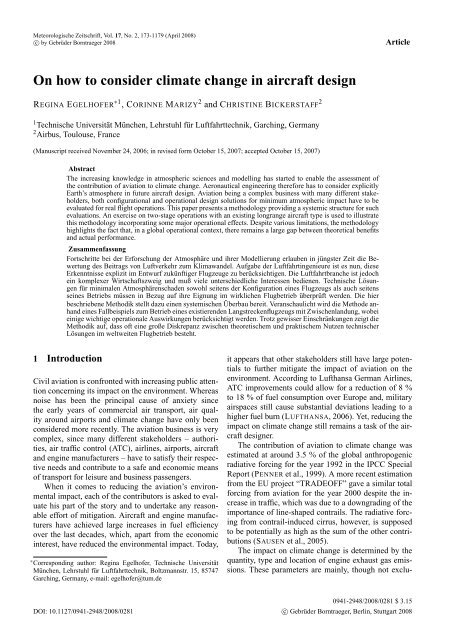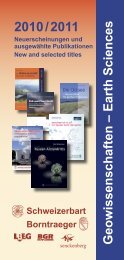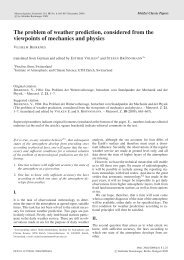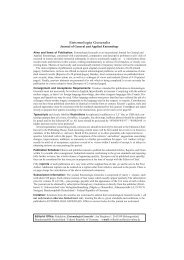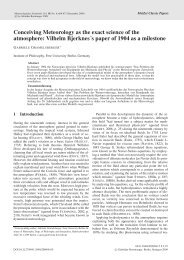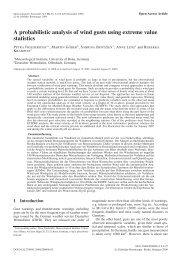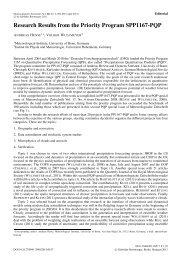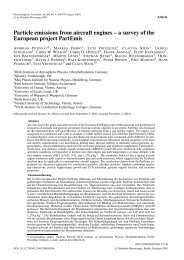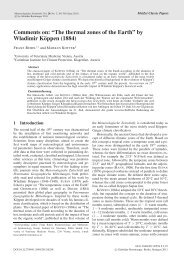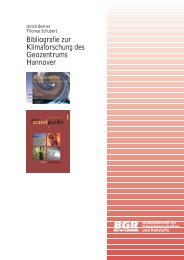On how to consider climate change in aircraft design
On how to consider climate change in aircraft design
On how to consider climate change in aircraft design
Create successful ePaper yourself
Turn your PDF publications into a flip-book with our unique Google optimized e-Paper software.
Meteorologische Zeitschrift, Vol. 17, No. 2, 173-1179 (April 2008)<br />
c○ by Gebrüder Borntraeger 2008<br />
Article<br />
<strong>On</strong> <strong>how</strong> <strong>to</strong> <strong>consider</strong> <strong>climate</strong> <strong>change</strong> <strong>in</strong> <strong>aircraft</strong> <strong>design</strong><br />
REGINA EGELHOFER ∗1 , CORINNE MARIZY 2 and CHRISTINE BICKERSTAFF 2<br />
1 Technische Universität München, Lehrstuhl für Luftfahrttechnik, Garch<strong>in</strong>g, Germany<br />
2 Airbus, Toulouse, France<br />
(Manuscript received November 24, 2006; <strong>in</strong> revised form Oc<strong>to</strong>ber 15, 2007; accepted Oc<strong>to</strong>ber 15, 2007)<br />
Abstract<br />
The <strong>in</strong>creas<strong>in</strong>g knowledge <strong>in</strong> atmospheric sciences and modell<strong>in</strong>g has started <strong>to</strong> enable the assessment of<br />
the contribution of aviation <strong>to</strong> <strong>climate</strong> <strong>change</strong>. Aeronautical eng<strong>in</strong>eer<strong>in</strong>g therefore has <strong>to</strong> <strong>consider</strong> explicitly<br />
Earth’s atmosphere <strong>in</strong> future <strong>aircraft</strong> <strong>design</strong>. Aviation be<strong>in</strong>g a complex bus<strong>in</strong>ess with many different stakeholders,<br />
both configurational and operational <strong>design</strong> solutions for m<strong>in</strong>imum atmospheric impact have <strong>to</strong> be<br />
evaluated for real flight operations. This paper presents a methodology provid<strong>in</strong>g a systemic structure for such<br />
evaluations. An exercise on two-stage operations with an exist<strong>in</strong>g longrange <strong>aircraft</strong> type is used <strong>to</strong> illustrate<br />
this methodology <strong>in</strong>corporat<strong>in</strong>g some major operational effects. Despite various limitations, the methodology<br />
highlights the fact that, <strong>in</strong> a global operational context, there rema<strong>in</strong>s a large gap between theoretical benefits<br />
and actual performance.<br />
Zusammenfassung<br />
Fortschritte bei der Erforschung der Atmosphäre und ihrer Modellierung erlauben <strong>in</strong> jüngster Zeit die Bewertung<br />
des Beitrags von Luftverkehr zum Klimawandel. Aufgabe der Luftfahrt<strong>in</strong>genieure ist es nun, diese<br />
Erkenntnisse explizit im Entwurf zukünftiger Flugzeuge zu berücksichtigen. Die Luftfahrtbranche ist jedoch<br />
e<strong>in</strong> komplexer Wirtschaftszweig und muß viele unterschiedliche Interessen bedienen. Technische Lösungen<br />
für m<strong>in</strong>imalen Atmosphärenschaden sowohl seitens der Konfiguration e<strong>in</strong>es Flugzeugs als auch seitens<br />
se<strong>in</strong>es Betriebs müssen <strong>in</strong> Bezug auf ihre Eignung im wirklichen Flugbetrieb überprüft werden. Die hier<br />
beschriebene Methodik stellt dazu e<strong>in</strong>en systemischen Überbau bereit. Veranschaulicht wird die Methode anhand<br />
e<strong>in</strong>es Fallbeispiels zum Betrieb e<strong>in</strong>es existierenden Langstreckenflugzeugs mit Zwischenlandung, wobei<br />
e<strong>in</strong>ige wichtige operationale Auswirkungen berücksichtigt werden. Trotz gewisser E<strong>in</strong>schränkungen zeigt die<br />
Methodik auf, dass oft e<strong>in</strong>e große Diskrepanz zwischen theoretischem und praktischem Nutzen technischer<br />
Lösungen im weltweiten Flugbetrieb besteht.<br />
1 Introduction<br />
Civil aviation is confronted with <strong>in</strong>creas<strong>in</strong>g public attention<br />
concern<strong>in</strong>g its impact on the environment. Whereas<br />
noise has been the pr<strong>in</strong>cipal cause of anxiety s<strong>in</strong>ce<br />
the early years of commercial air transport, air quality<br />
around airports and <strong>climate</strong> <strong>change</strong> have only been<br />
<strong>consider</strong>ed more recently. The aviation bus<strong>in</strong>ess is very<br />
complex, s<strong>in</strong>ce many different stakeholders – authorities,<br />
air traffic control (ATC), airl<strong>in</strong>es, airports, <strong>aircraft</strong><br />
and eng<strong>in</strong>e manufacturers – have <strong>to</strong> satisfy their respective<br />
needs and contribute <strong>to</strong> a safe and economic means<br />
of transport for leisure and bus<strong>in</strong>ess passengers.<br />
When it comes <strong>to</strong> reduc<strong>in</strong>g the aviation’s environmental<br />
impact, each of the contribu<strong>to</strong>rs is asked <strong>to</strong> evaluate<br />
his part of the s<strong>to</strong>ry and <strong>to</strong> undertake any reasonable<br />
effort of mitigation. Aircraft and eng<strong>in</strong>e manufacturers<br />
have achieved large <strong>in</strong>creases <strong>in</strong> fuel efficiency<br />
over the last decades, which, apart from the economic<br />
<strong>in</strong>terest, have reduced the environmental impact. Today,<br />
∗ Correspond<strong>in</strong>g author: Reg<strong>in</strong>a Egelhofer, Technische Universität<br />
München, Lehrstuhl für Luftfahrttechnik, Boltzmannstr. 15, 85747<br />
Garch<strong>in</strong>g, Germany, e-mail: egelhofer@tum.de<br />
it appears that other stakeholders still have large potentials<br />
<strong>to</strong> further mitigate the impact of aviation on the<br />
environment. Accord<strong>in</strong>g <strong>to</strong> Lufthansa German Airl<strong>in</strong>es,<br />
ATC improvements could allow for a reduction of 8 %<br />
<strong>to</strong> 18 % of fuel consumption over Europe and, military<br />
airspaces still cause substantial deviations lead<strong>in</strong>g <strong>to</strong> a<br />
higher fuel burn (LUFTHANSA, 2006). Yet, reduc<strong>in</strong>g the<br />
impact on <strong>climate</strong> <strong>change</strong> still rema<strong>in</strong>s a task of the <strong>aircraft</strong><br />
<strong>design</strong>er.<br />
The contribution of aviation <strong>to</strong> <strong>climate</strong> <strong>change</strong> was<br />
estimated at around 3.5 % of the global anthropogenic<br />
radiative forc<strong>in</strong>g for the year 1992 <strong>in</strong> the IPCC Special<br />
Report (PENNER et al., 1999). A more recent estimation<br />
from the EU project “TRADEOFF” gave a similar <strong>to</strong>tal<br />
forc<strong>in</strong>g from aviation for the year 2000 despite the <strong>in</strong>crease<br />
<strong>in</strong> traffic, which was due <strong>to</strong> a downgrad<strong>in</strong>g of the<br />
importance of l<strong>in</strong>e-shaped contrails. The radiative forc<strong>in</strong>g<br />
from contrail-<strong>in</strong>duced cirrus, <strong>how</strong>ever, is supposed<br />
<strong>to</strong> be potentially as high as the sum of the other contributions<br />
(SAUSEN et al., 2005).<br />
The impact on <strong>climate</strong> <strong>change</strong> is determ<strong>in</strong>ed by the<br />
quantity, type and location of eng<strong>in</strong>e exhaust gas emissions.<br />
These parameters are ma<strong>in</strong>ly, though not exclu-<br />
DOI: 10.1127/0941-2948/2008/0281<br />
0941-2948/2008/0281 $ 3.15<br />
c○ Gebrüder Borntraeger, Berl<strong>in</strong>, Stuttgart 2008
174 R. Egelhofer et al.: <strong>On</strong> <strong>how</strong> <strong>to</strong> <strong>consider</strong> <strong>climate</strong> <strong>change</strong> Meteorol. Z., 17, 2008<br />
sively, determ<strong>in</strong>ed through the <strong>design</strong> of an <strong>aircraft</strong> and<br />
its eng<strong>in</strong>e. Whereas non-optimal flight rout<strong>in</strong>g, hold<strong>in</strong>g<br />
patterns and other extra-fuel-consum<strong>in</strong>g events are difficult<br />
<strong>to</strong> account for <strong>in</strong> <strong>aircraft</strong> <strong>design</strong>, as they are difficult<br />
<strong>to</strong> predict, the scheduled flight network is well def<strong>in</strong>ed<br />
and can therefore be <strong>in</strong>terl<strong>in</strong>ked with the <strong>design</strong> process<br />
for new <strong>aircraft</strong> (i.e., along with other parameters such<br />
as need for specific ranges and/or capacities). This l<strong>in</strong>kage<br />
is particularly important when it comes <strong>to</strong> evaluat<strong>in</strong>g<br />
the atmospheric impact of an <strong>aircraft</strong> concept.<br />
The methodology presented here provides a systemic<br />
superstructure for the evaluation of the impact on the<br />
global atmosphere of an <strong>aircraft</strong> concept, embedded <strong>in</strong><br />
global operations, and thus prepares for its optimisation<br />
for m<strong>in</strong>imum contribution <strong>to</strong> <strong>climate</strong> <strong>change</strong>. The<br />
methodology does not take <strong>in</strong><strong>to</strong> account other environmental<br />
effects such as noise, local air quality, occupational<br />
health and environmental impacts dur<strong>in</strong>g the production<br />
of <strong>aircraft</strong>. It focuses on effects of <strong>aircraft</strong> operations<br />
on a global level, i.e. on <strong>climate</strong> <strong>change</strong>. As<br />
a concrete example for “atmosphere-compatible” <strong>design</strong><br />
approaches, two-stage operations are assessed <strong>in</strong><br />
this regard. This example will also highlight operational<br />
implications of such approaches for “environmentally<br />
friendly” aviation.<br />
2 Relevance of the environment <strong>in</strong><br />
aviation<br />
The protection of the environment has <strong>in</strong>fluenced the<br />
development of the aviation system for a long time.<br />
In the public arena, aviation is well appreciated as a<br />
convenient, <strong>in</strong>expensive, safe and primarily fast means<br />
of transport, by bus<strong>in</strong>ess and <strong>to</strong>urists on the one side,<br />
strongly analysed and criticised by airport neighbours<br />
and environmental organisations on the other side. Aircraft<br />
have become far more fuel-efficient dur<strong>in</strong>g the<br />
last decades through advances <strong>in</strong> lightweight structures,<br />
the reduction of aerodynamic drag and more efficient<br />
jet eng<strong>in</strong>es. Emission <strong>in</strong>dices of nitrogen oxides (NO x )<br />
have been and are still be<strong>in</strong>g further reduced with <strong>in</strong>novative<br />
combus<strong>to</strong>r concepts and heat ex<strong>change</strong>rs etc.<br />
(EGELHOFER, 2006). As fuel contributes <strong>to</strong> a significant<br />
extent <strong>to</strong> <strong>aircraft</strong> operat<strong>in</strong>g cost and as fuel prices<br />
cont<strong>in</strong>ue <strong>to</strong> <strong>in</strong>crease, the reduction of fuel consumption<br />
rema<strong>in</strong>s a major concern for future <strong>aircraft</strong>. Along with<br />
decreas<strong>in</strong>g fuel consumption, carbon dioxide emissions<br />
are reduced proportionally. Carbon dioxide be<strong>in</strong>g an important<br />
contribu<strong>to</strong>r <strong>to</strong> the greenhouse effect, the impact<br />
of an <strong>in</strong>dividual <strong>aircraft</strong> on <strong>climate</strong> <strong>change</strong> should thus<br />
cont<strong>in</strong>ue <strong>to</strong> be reduced <strong>in</strong> future, even if the impact of<br />
other exhaust products needs <strong>to</strong> be evaluated <strong>in</strong> addition.<br />
However, it is not the <strong>aircraft</strong> itself, but its operation<br />
that has an environmental impact, so that the aviation<br />
system as a whole needs <strong>to</strong> be <strong>consider</strong>ed when evaluat<strong>in</strong>g<br />
the atmospheric impact of an <strong>aircraft</strong> concept. Many<br />
Aircraft<br />
Eng<strong>in</strong>e<br />
Airports<br />
Certification<br />
Airl<strong>in</strong>es<br />
Operations<br />
Passengers<br />
ATC<br />
Military<br />
Environment<br />
Figure 1: Some of the most relevant stakeholders of aviation, who<br />
have an <strong>in</strong>fluence on the operation of commercial <strong>aircraft</strong>.<br />
different stakeholders have an impact on the “production”<br />
of each flight. See Figure 1 for just some examples.<br />
The <strong>consider</strong>ation of <strong>climate</strong> <strong>change</strong> <strong>in</strong> <strong>aircraft</strong> <strong>design</strong><br />
turns out <strong>to</strong> be a complex task as no only does it <strong>in</strong>volve<br />
the <strong>aircraft</strong> and eng<strong>in</strong>e manufacturers, but also airl<strong>in</strong>es<br />
(bus<strong>in</strong>ess models, fleet plann<strong>in</strong>g), airports (capacity,<br />
traffic management, environmental restrictions), Air<br />
Traffic Management (ATM) and ATC (quality of flight<br />
rout<strong>in</strong>g, congestion), certification and even the military<br />
(restricted airspaces). Passengers are <strong>in</strong>volved both by<br />
their personal requirements for a flight (e.g., desire for<br />
convenience and speed and environmental consciousness)<br />
and by their behaviour dur<strong>in</strong>g the actual provision<br />
of service (e.g., an <strong>aircraft</strong> has <strong>to</strong> fly faster <strong>to</strong> catch up<br />
follow<strong>in</strong>g delays caused by passengers arriv<strong>in</strong>g late, and<br />
thus consumes more fuel).<br />
Each of the issues referred above is <strong>in</strong>terl<strong>in</strong>ked directly<br />
or <strong>in</strong>directly with <strong>aircraft</strong> <strong>design</strong>. The <strong>design</strong> eng<strong>in</strong>eer<br />
then has the difficult task of try<strong>in</strong>g <strong>to</strong> handle many<br />
different and often contradic<strong>to</strong>ry requirements, one of<br />
which is a m<strong>in</strong>imum contribution <strong>to</strong> <strong>climate</strong> <strong>change</strong>.<br />
3 Design process for m<strong>in</strong>imum<br />
atmospheric impact<br />
In current <strong>aircraft</strong> optimisation loops, noise starts out be<strong>in</strong>g<br />
<strong>in</strong>tegrated as an important requirement, even at prelim<strong>in</strong>ary<br />
<strong>design</strong> level. As referred above, emissions are<br />
largely m<strong>in</strong>imised <strong>in</strong> <strong>aircraft</strong> <strong>design</strong> through the m<strong>in</strong>imisation<br />
of fuel consumption, which also impacts on<br />
direct operational cost. An effective evaluation of aviation’s<br />
emissions’ impact on the atmosphere is undertaken<br />
only after attempt<strong>in</strong>g <strong>to</strong> <strong>consider</strong> the complete<br />
problem and does not apply <strong>to</strong> a s<strong>in</strong>gle <strong>aircraft</strong> type,<br />
but rather <strong>to</strong> the global fleet (see Figure 2). Few projects<br />
Bot<strong>to</strong>m Up<br />
Impact on <strong>climate</strong> <strong>change</strong> (RF, ∆T, GWP etc.)<br />
Atmospheric model<br />
Estimation of emissions -> Scenario<br />
Estimation of flight profiles<br />
Global flight operations over one year<br />
Figure 2: Current evaluation of the atmospheric impact of aviation:<br />
bot<strong>to</strong>m up method. No feedback <strong>to</strong> <strong>aircraft</strong> <strong>design</strong>.
Meteorol. Z., 17, 2008 R. Egelhofer et al.: <strong>On</strong> <strong>how</strong> <strong>to</strong> <strong>consider</strong> <strong>climate</strong> <strong>change</strong> 175<br />
Exist<strong>in</strong>g A/C types<br />
Future A/C<br />
concept(s)<br />
A/C fleet <strong>in</strong> 20XX<br />
A/C<br />
requirements<br />
Fleet<br />
composition<br />
Market SCENARIOS<br />
Market research<br />
• New A/C requirements<br />
• A/C fleet for any year <strong>in</strong>clud<strong>in</strong>g<br />
new A/C penetration<br />
Route network<br />
OPERATIONS<br />
EMISSION SCENARIOS<br />
Geographically determ<strong>in</strong>ed (altitude, latitude, longitude)<br />
and quantified emissions over one year<br />
INVESTIGATED SCENARIO<br />
Emission scenario<br />
<strong>in</strong>clud<strong>in</strong>g new A/C type(s)<br />
REFERENCE SCENARIO<br />
Reference emission scenario<br />
without new A/C type(s)<br />
Aircraft siz<strong>in</strong>g<br />
Atmospheric models / metrics <strong>to</strong> enable<br />
ESTIMATE OF CLIMATE IMPACT<br />
Figure 3: Design approach for m<strong>in</strong>imum atmospheric impact, with feedback <strong>to</strong> <strong>aircraft</strong> <strong>design</strong>. Future <strong>aircraft</strong> <strong>design</strong>s are embedded <strong>in</strong> a<br />
global fleet. Market scenarios help def<strong>in</strong><strong>in</strong>g future requirements for <strong>aircraft</strong> and traffic demand. Operations are simulated <strong>in</strong> order <strong>to</strong> build<br />
up detailed emission scenarios, one with and one without the <strong>aircraft</strong> <strong>to</strong> be <strong>in</strong>vestigated. Upon these results, an atmospheric metric shall<br />
allow assess<strong>in</strong>g the environmental impact of the <strong>consider</strong>ed <strong>design</strong> <strong>change</strong>s and feed back <strong>in</strong><strong>to</strong> the <strong>in</strong>itial <strong>design</strong> study. The methodology<br />
aims at <strong>aircraft</strong> <strong>design</strong> for m<strong>in</strong>imum atmospheric impact.<br />
such as TRADEOFF and SCENIC have performed such<br />
a study <strong>to</strong> its full extent (TRADEOFF f<strong>in</strong>al report: ISAK-<br />
SEN et al., 2003; several publications from SCENIC <strong>in</strong><br />
preparation). This activity is now pursued <strong>in</strong> the European<br />
project QUANTIFY (www.ip-quantify.eu). Other<br />
projects s<strong>to</strong>p at the level of emission scenarios that<br />
are then provided for consecutive research (AERO2K<br />
project, see EYERS et al., 2004). Such complex emission<br />
scenarios represent the real emissions <strong>in</strong> the utmost precision<br />
for past years, and good estimates for future years.<br />
Such an approach is important <strong>to</strong> provide a sufficiently<br />
reliable representation of the global situation <strong>in</strong> terms of<br />
pollution and the consequent possible <strong>climate</strong> <strong>change</strong> <strong>in</strong><br />
order <strong>to</strong> enable necessary political action <strong>to</strong> be taken. If<br />
want<strong>in</strong>g <strong>to</strong> <strong>consider</strong> <strong>climate</strong> <strong>change</strong> <strong>in</strong> the <strong>design</strong> of future<br />
transport systems, and more particularly <strong>in</strong> that of<br />
future <strong>aircraft</strong>, such an estimate of the <strong>climate</strong> <strong>change</strong><br />
impact must be extremely simplified and made flexible<br />
so that <strong>aircraft</strong> <strong>design</strong> options can be weighed aga<strong>in</strong>st<br />
each other <strong>in</strong> terms of their <strong>climate</strong> impact, still keep<strong>in</strong>g<br />
a sufficiently reliable global picture not <strong>to</strong> falsify results.<br />
Our approach (see Figure 3 and EGELHOFER, 2006)<br />
embeds a new <strong>aircraft</strong> concept <strong>in</strong> a global fleet on a<br />
real route network. With a market forecast and <strong>aircraft</strong><br />
performance data, global emission scenarios are created.<br />
This process enables the assessment of the various<br />
operational adaptations such as new flight altitudes or<br />
speeds, which will result from the new <strong>aircraft</strong> concept.<br />
For the subsequent evaluation of the impact on the atmosphere,<br />
some atmospheric metrics and modell<strong>in</strong>g will<br />
be <strong>in</strong>cluded <strong>in</strong> the process as soon as these are available.<br />
This could be, e.g., Radiative Forc<strong>in</strong>g, Global Warm<strong>in</strong>g<br />
Potential and Global Temperature Potential (see SHINE<br />
et al., 2005, and BERNTSEN et al., 2005). A sufficient<br />
reliability of the metrics is a prerequisite for their confident<br />
<strong>in</strong>tegration <strong>in</strong><strong>to</strong> the <strong>design</strong> process. Vary<strong>in</strong>g <strong>aircraft</strong><br />
parameters of the <strong>in</strong>vestigated <strong>aircraft</strong> concept enables a<br />
comparative study between the result<strong>in</strong>g emission scenarios<br />
and their respective atmospheric impacts.<br />
For the application of the methodology for new <strong>aircraft</strong>,<br />
data for the future global fleet have <strong>to</strong> be estimated,<br />
which necessitates sound support from market<br />
research. The comprehensive character of the approach<br />
makes a proper organisation and sett<strong>in</strong>g up of parameters<br />
and methods essential. The precision levels of all<br />
modules have <strong>to</strong> be reasonably aligned and the consistency<br />
of the data has <strong>to</strong> be guaranteed. Not only does a<br />
real <strong>in</strong>tegration <strong>in</strong> <strong>aircraft</strong> <strong>design</strong> of the impact on <strong>climate</strong><br />
<strong>change</strong> enable its evaluation or m<strong>in</strong>imisation, but<br />
it also enables tradeoffs with noise and local air quality,<br />
that tend <strong>to</strong> foster other <strong>design</strong> solutions. The approach<br />
aims at contribut<strong>in</strong>g <strong>to</strong> a reasonable compromise of <strong>design</strong><br />
parameters for economically viable, environmentally<br />
friendly and thus susta<strong>in</strong>able <strong>aircraft</strong>. At its current<br />
maturity level, despite immediate limitations, the<br />
methodology can already give some useful results and
176 R. Egelhofer et al.: <strong>On</strong> <strong>how</strong> <strong>to</strong> <strong>consider</strong> <strong>climate</strong> <strong>change</strong> Meteorol. Z., 17, 2008<br />
Figure 4: Relative fuel consumption <strong>in</strong> kg/km for an example longrange<br />
<strong>aircraft</strong>, depend<strong>in</strong>g on the distance flown. Calculated based<br />
on optimised mission profiles for each distance, with an average load<br />
fac<strong>to</strong>r. Data from Airbus.<br />
these presage an effective <strong>in</strong>fluence on the <strong>aircraft</strong> <strong>design</strong><br />
process.<br />
4 Two-stage operations as example of use<br />
of the methodology<br />
For illustration of the methodology presented <strong>in</strong> section<br />
3, a very simplified example study was conducted.<br />
For this purpose, two-stage operations on an exist<strong>in</strong>g<br />
longrange <strong>aircraft</strong> type were chosen. The same methodology<br />
could also be applied <strong>to</strong> additionally reflect configurational<br />
advances <strong>in</strong> <strong>aircraft</strong> <strong>design</strong>.<br />
The market basis (see Figure 3) is drawn from data<br />
from the Official Airl<strong>in</strong>e Guide (OAG) for the year 2005.<br />
For the time be<strong>in</strong>g, fuel burn (proportional <strong>to</strong> CO 2 and<br />
H 2 O emissions) was chosen as metric for the impact of<br />
aviation on <strong>climate</strong> <strong>change</strong>, as not other appropriate atmospheric<br />
metric or model was available <strong>to</strong> the authors.<br />
This procedure does not fully exploit the methodology<br />
such as presented <strong>in</strong> section 3, but illustrates its potential<br />
capacity.<br />
In steady flight, the thrust of an <strong>aircraft</strong> is equivalent<br />
<strong>to</strong> its drag, much of which is directly l<strong>in</strong>ked <strong>to</strong> the<br />
aerodynamic lift of the <strong>aircraft</strong>. Consequently, an <strong>in</strong>creased<br />
<strong>aircraft</strong> weight demands more thrust and leads<br />
<strong>to</strong> higher fuel consumption. <strong>On</strong> longrange flights, <strong>aircraft</strong><br />
use a lot of fuel just <strong>to</strong> transport fuel, which leads <strong>to</strong><br />
a high relative fuel consumption on very long distances.<br />
<strong>On</strong> the other hand, the takeoff procedure is very fuelconsum<strong>in</strong>g,<br />
which leads <strong>to</strong> high consumption on short<br />
routes. For each <strong>aircraft</strong>, a distance for m<strong>in</strong>imum fuel<br />
consumption per flown kilometre can be determ<strong>in</strong>ed. In<br />
the example given <strong>in</strong> Figure 4, the optimum stage length<br />
is 4300 km.<br />
An approach <strong>to</strong> reduc<strong>in</strong>g the fuel consumption for<br />
longrange flights is <strong>to</strong> separate the flown distance <strong>in</strong><strong>to</strong><br />
two or more stages (“two-stage operation” or “multistage<br />
operation”), of which each length should be as<br />
close as possible <strong>to</strong> this m<strong>in</strong>imum.<br />
4.1 Theoretical fuel reduction potential with<br />
two-stage operations<br />
If the distance <strong>to</strong> be flown is only slightly longer than<br />
this optimum stage length (4300 km <strong>in</strong> our example),<br />
a two-stage operation may not save fuel, as the fuelconsum<strong>in</strong>g<br />
takeoff procedure would then weigh heavier<br />
than the sav<strong>in</strong>g by not “transport<strong>in</strong>g fuel”. The curve<br />
plotted <strong>in</strong> Figure 4 can be approached by a function of<br />
the type<br />
y = ax+b+ c (4.1)<br />
x<br />
where x is the distance <strong>to</strong> be flown and y is the relative<br />
fuel consumption per flown kilometre. The parameters<br />
a, b and c are chosen such that the curve is best estimated<br />
for stage lengths above 300 km and under 12,000<br />
km. Note that longrange <strong>aircraft</strong> do fly some very short<br />
sec<strong>to</strong>rs. The potential relative fuel sav<strong>in</strong>g ∆y of a twostage<br />
operation is<br />
∆y = y <strong>to</strong>tal − y 1 · x 1 + y 2 · x 2<br />
x <strong>to</strong>tal<br />
(4.2)<br />
where x 1 and x 2 are the lengths of the two stages, y 1<br />
and y 2 are the respective relative fuel consumptions of<br />
the two stages and x <strong>to</strong>tal is the <strong>to</strong>tal distance with a <strong>to</strong>tal<br />
relative fuel consumption of y <strong>to</strong>tal , if flown <strong>in</strong> one flight.<br />
Consider<strong>in</strong>g that x <strong>to</strong>tal = x 1 + x 2 and equation (4.1), we<br />
get<br />
∆y = 2ax 1 − c+2ax2 1<br />
x <strong>to</strong>tal<br />
(4.3)<br />
Divid<strong>in</strong>g (4.3) by (4.1) gives the potential fuel economy<br />
ratio e:<br />
e = −2ax2 1 + 2ax 1x <strong>to</strong>tal − c<br />
ax 2 <strong>to</strong>tal + bx <strong>to</strong>tal + c<br />
(4.4)<br />
Table 1: Theoretical maximum fuel economy operat<strong>in</strong>g <strong>in</strong> two<br />
stages on a great circle route, with an exist<strong>in</strong>g longrange <strong>aircraft</strong>,<br />
and respective fractions of flights and available seat kilometres<br />
(ASK) of the global traffic of <strong>aircraft</strong> with more than one hundred<br />
seats.<br />
Theoretical Distance greater Fraction Fraction<br />
fuel economy than [km] Flights ASK<br />
0 % 6100 4.2 % 37 %<br />
1 % 6600 3.4 % 32 %<br />
2 % 7200 2.7 % 27 %<br />
4 % 8700 1.5 % 17 %<br />
6 % 10,300 0.43 % 5.5 %<br />
8 % 12,300 0.05 % 0.5 %<br />
Plott<strong>in</strong>g function e(x <strong>to</strong>tal , x 1 ) s<strong>how</strong>s for which <strong>to</strong>tal<br />
distances and which partial distances <strong>consider</strong>able fuel<br />
sav<strong>in</strong>gs can be obta<strong>in</strong>ed, if operat<strong>in</strong>g as two-stage operation<br />
(see Figure 5).
Meteorol. Z., 17, 2008 R. Egelhofer et al.: <strong>On</strong> <strong>how</strong> <strong>to</strong> <strong>consider</strong> <strong>climate</strong> <strong>change</strong> 177<br />
Figure 5: Theoretical fuel economy for an example longrange <strong>aircraft</strong><br />
with two-stage operations <strong>in</strong> percent (isol<strong>in</strong>es), depend<strong>in</strong>g on<br />
the <strong>to</strong>tal distance (abscissa) and the lengths of the two stages with<br />
two-stage operations (ord<strong>in</strong>ate). The dash-dotted l<strong>in</strong>e gives the respective<br />
optimum stage length (x 1 = x 2 ).<br />
4.2 Market share of routes capable of<br />
two-stage operations<br />
Consider<strong>in</strong>g, e.g., a fuel sav<strong>in</strong>g of 2 % “<strong>in</strong>terest<strong>in</strong>g”,<br />
routes of more than 7200 km would be worth a twostage<br />
operation with the <strong>consider</strong>ed example <strong>aircraft</strong>. In<br />
the global air traffic (OAG data from 2005), such flights<br />
represent only 2.7 % of all annual flights by <strong>aircraft</strong><br />
greater than one hundred seats, but 27 % of available<br />
seat-kilometres (ASK) (see Table 1). Multiply<strong>in</strong>g these<br />
2 % with 27 % gives around half a percent of fuel sav<strong>in</strong>g<br />
as a very rough estimate (<strong>consider</strong><strong>in</strong>g global ASK<br />
and fuel consumption percentages proportionate). The<br />
maximum theoretical fuel economy with this example<br />
<strong>aircraft</strong> would be atta<strong>in</strong>ed if operat<strong>in</strong>g it on all routes<br />
above 6100 km (correspond<strong>in</strong>g <strong>to</strong> a positive fuel economy)<br />
at the respective optimum stage length (x 1 = x 2 ).<br />
Despite the high fraction of routes “capable of a twostage<br />
operation”, i.e. with positive fuel economy, this<br />
would still only account for around one percent of the<br />
global fuel consumption of <strong>aircraft</strong> with more than one<br />
hundred seats. The estimate is based on the follow<strong>in</strong>g<br />
equation, where E global is the <strong>to</strong>tal theoretically atta<strong>in</strong>able<br />
fuel economy with our example <strong>aircraft</strong> for the<br />
global traffic:<br />
E global =<br />
∑<br />
Distances≥6100 km<br />
∆Fraction ASK Distance · e Distance<br />
(4.5)<br />
Optimised flight plans with the respectively best <strong>aircraft</strong><br />
type on each route would lead <strong>to</strong> higher economies.<br />
<strong>On</strong> the other hand, the <strong>consider</strong>ation uses the optimum<br />
stage lengths (x 1 = x 2 ), which <strong>in</strong> most cases is not<br />
achievable on realistic flight paths. Additionally, <strong>to</strong>tal<br />
flight distance will lengthen as <strong>in</strong>termediate airports are<br />
not necessarily available on the great circle between departure<br />
and arrival po<strong>in</strong>t. This estimate gives an idea of<br />
Figure 6: Variation of payload fuel efficiency with range and <strong>design</strong><br />
range: swept w<strong>in</strong>g kerosene-fuelled <strong>aircraft</strong> (from GREEN (2005),<br />
arranged by SCHNIEDER and HYDE (2006)).<br />
the order of magnitude of the fuel sav<strong>in</strong>g <strong>to</strong> be atta<strong>in</strong>ed<br />
without chang<strong>in</strong>g the <strong>aircraft</strong> <strong>design</strong>.<br />
4.3 Theoretical reduction potential with<br />
re<strong>design</strong>ed <strong>aircraft</strong><br />
Assum<strong>in</strong>g that it would be viable <strong>to</strong> have such types,<br />
a higher potential for sav<strong>in</strong>gs could be atta<strong>in</strong>ed, if <strong>aircraft</strong><br />
were <strong>design</strong>ed for shorter ranges. The smaller fuel<br />
quantities needed would allow a lower structural weight<br />
of the <strong>aircraft</strong>. A lighter structure aga<strong>in</strong> leads <strong>to</strong> reduced<br />
fuel consumption (see 4.1), which feeds back <strong>in</strong><strong>to</strong> a reduced<br />
structural weight. Accord<strong>in</strong>g <strong>to</strong> GREEN (2005),<br />
an <strong>aircraft</strong> <strong>design</strong>ed for 7400 km operat<strong>in</strong>g <strong>in</strong> stages on<br />
current real routes would save 10 % <strong>in</strong> fuel burn compared<br />
<strong>to</strong> an <strong>aircraft</strong> <strong>design</strong>ed for 14,800 km. Compared<br />
<strong>to</strong> 4.1, this estimation allows for real routes, but still is<br />
not representative for the global traffic, but only for one<br />
longrange <strong>aircraft</strong> type, just as <strong>in</strong> our study. For comparison,<br />
our example <strong>aircraft</strong> would provide around 10 %<br />
of fuel sav<strong>in</strong>g operat<strong>in</strong>g <strong>in</strong> two equal stages on a <strong>to</strong>tal<br />
distance of 14,800 km without be<strong>in</strong>g re<strong>design</strong>ed. Push<strong>in</strong>g<br />
this theoretical approach <strong>to</strong> its extreme, optimis<strong>in</strong>g<br />
range and seat capacity at the same time would lead <strong>to</strong><br />
much higher sav<strong>in</strong>gs. As s<strong>how</strong>n <strong>in</strong> Figure 6, the payload<br />
fuel efficiency of an <strong>aircraft</strong> <strong>design</strong>ed for 5000 km on a<br />
5000 km leg, and furthermore assum<strong>in</strong>g optimum seat<br />
capacity, would exceed the one of an <strong>aircraft</strong> <strong>design</strong>ed<br />
for 15,000 km by almost 30 %. This benefit rema<strong>in</strong>s theoretical,<br />
as <strong>aircraft</strong> cannot be <strong>design</strong>ed specifically for<br />
each needed range, neither for each seat capacity. However,<br />
s<strong>in</strong>ce this paper was presented, Green has corrected<br />
his calculations and his theoretical estimates of the percentage<br />
are even greater (GREEN, 2006).<br />
As expla<strong>in</strong>ed <strong>in</strong> section 4.1., these theoretical ga<strong>in</strong>s<br />
for one s<strong>in</strong>gle <strong>aircraft</strong> or route sum up <strong>to</strong> a few percent<br />
only when put <strong>in</strong><strong>to</strong> perspective of the global route<br />
network. For comparison, an Airbus <strong>in</strong>ternal study estimated<br />
the fuel sav<strong>in</strong>g benefit of two-stage operations at<br />
2.6 % on a global (commercial <strong>aircraft</strong> greater than one<br />
hundred seats) level (SCHNIEDER and HYDE 2006), al-
178 R. Egelhofer et al.: <strong>On</strong> <strong>how</strong> <strong>to</strong> <strong>consider</strong> <strong>climate</strong> <strong>change</strong> Meteorol. Z., 17, 2008<br />
ready tak<strong>in</strong>g <strong>in</strong><strong>to</strong> account some of the major drawbacks<br />
(see section 4.5.).<br />
4.4 Impact of two-stage operations on<br />
<strong>climate</strong> <strong>change</strong><br />
With the fuel sav<strong>in</strong>g, the masses of products of combustion<br />
CO 2 and H 2 O emitted <strong>in</strong><strong>to</strong> the atmosphere are reduced,<br />
and so also their direct effects on <strong>climate</strong>. The potential<br />
impact of other pollutants, especially of nitrogen<br />
oxides, is more uncerta<strong>in</strong> as it results <strong>in</strong> a comb<strong>in</strong>ation<br />
of two effects that can be contradic<strong>to</strong>ry: the reduction of<br />
emissions and their radiative effects by fuel sav<strong>in</strong>g, and<br />
the <strong>in</strong>creased production of emissions at lower altitudes.<br />
Today large uncerta<strong>in</strong>ties rema<strong>in</strong> concern<strong>in</strong>g the positive/negative<br />
impact versus small vertical fluctuations at<br />
these altitudes. Given the lack of reliable metrics, only<br />
studies with atmospheric models can evaluate the potential<br />
benefit appropriately.<br />
Another consequence of emissions is the formation<br />
of condensation trails, or contrails, and their persistence<br />
when particular atmospheric conditions (supersaturation<br />
with respect <strong>to</strong> ice) occur dur<strong>in</strong>g the flight; these contrails<br />
contribute <strong>to</strong> <strong>in</strong>creased radiative forc<strong>in</strong>g as they<br />
have similar effect as natural clouds. The potential impact<br />
of two-stage operations is very uncerta<strong>in</strong>, as the atmospheric<br />
conditions depend not only on the altitude,<br />
but also on latitude, season and time of day of a flight.<br />
<strong>On</strong>ce aga<strong>in</strong>, only studies with atmospheric models can<br />
estimate their radiative impact. And <strong>in</strong> that case, the used<br />
traffic scenario would need <strong>to</strong> break down flight operations<br />
not only <strong>to</strong> their location, but also <strong>to</strong> their exact<br />
tim<strong>in</strong>g (hours, or at least daytime).<br />
If the two-stage operations tend <strong>to</strong> reduce fuel consumption<br />
dur<strong>in</strong>g the flight, their application will also <strong>in</strong>crease<br />
the number of land<strong>in</strong>g and takeoff (LTO) cycles<br />
<strong>in</strong> the airport areas. As a direct consequence pollutants<br />
emitted at low altitudes will <strong>in</strong>crease, especially beneath<br />
the atmospheric mix<strong>in</strong>g height (∼ 3000 ft). Two species<br />
are more particularly concerned: nitrogen oxides NO X<br />
and particles. For local air quality preservation, requirements<br />
from local authorities might limit air traffic, for<br />
example by fix<strong>in</strong>g annual LTO movements or a quota of<br />
permitted emissions per source (see EGELHOFER et al.,<br />
2006). It is possible <strong>to</strong> make <strong>design</strong> tradeoffs that lead <strong>to</strong><br />
a reduction of the emissions of NO X dur<strong>in</strong>g takeoff, with<br />
some potential penalties for fuel consumption at altitude<br />
as these tradeoffs <strong>in</strong>fluence directly the eng<strong>in</strong>e <strong>design</strong>.<br />
This type of environmental measures could impair the<br />
<strong>in</strong>itially assumed benefit of two-stage operations.<br />
A profound assessment of the benefit of two-stage<br />
operations for environmental impact would presume the<br />
<strong>in</strong>tegration of a reliable atmospheric model or metric <strong>in</strong><br />
the loop.<br />
4.5 Operational <strong>in</strong>volvements and economic<br />
<strong>in</strong>terest of two-stage operations<br />
The potential fuel sav<strong>in</strong>gs presented <strong>in</strong> chapters 4.1 <strong>to</strong><br />
4.3 are theoretical. Several aspects would counteract the<br />
benefit of two-stage operations:<br />
– Availability of appropriate airports: Even if an airport<br />
was available near the mid-range of a certa<strong>in</strong><br />
route, it is not sure it would be able <strong>to</strong> handle additional<br />
traffic, and that it has the necessary <strong>in</strong>frastructure<br />
(runway strength, fuel supply, navigation<br />
aids etc.).<br />
– Ma<strong>in</strong>tenance cost and higher fatigue of the pressure<br />
cab<strong>in</strong> due <strong>to</strong> the higher number of flight cycles<br />
– Additional land<strong>in</strong>g and takeoff cycles affect<strong>in</strong>g local<br />
air quality (see 4.4) and noise concerns, especially<br />
important at busy airports<br />
– Organisational effort for airl<strong>in</strong>es: crew management,<br />
airl<strong>in</strong>e subsidies at mid-way airports<br />
– Less flexibility for airl<strong>in</strong>es <strong>to</strong> choose routes, if <strong>aircraft</strong><br />
are <strong>design</strong>ed <strong>to</strong> lower ranges<br />
– Value of time for the passenger: A full land<strong>in</strong>g<br />
and takeoff cycle with refuell<strong>in</strong>g takes one <strong>to</strong> two<br />
hours, which might not be acceptable for many<br />
passengers, those with children, the old and those<br />
pay<strong>in</strong>g high ticket prices (bus<strong>in</strong>ess passengers).<br />
<strong>On</strong>e hour for 300 passengers would then cost<br />
up <strong>to</strong> 15,000 Euro based on standard values recommended<br />
by EUROCONTROL (2005). However,<br />
these numbers are based on just one study out of<br />
several. The confidence <strong>in</strong> such numbers is thus<br />
very limited.<br />
The economic <strong>in</strong>terest of two-stage operations, justify<strong>in</strong>g<br />
the effort of severe modifications of the aviation<br />
system, is impacted by all of the aspects mentioned<br />
above. Two-stage operations are <strong>in</strong>terest<strong>in</strong>g and applicable<br />
on specific routes only, but cannot be <strong>consider</strong>ed a<br />
generally fuel- or <strong>climate</strong> impact- reduc<strong>in</strong>g measure <strong>to</strong>day.<br />
An expansion of such operations would presume<br />
substantial adaptations <strong>in</strong> the aviation <strong>in</strong>frastructure, especially<br />
at airports. In the end, the overall benefit of twostage<br />
operations depends essentially on the fuel price<br />
and wider economics.<br />
As <strong>in</strong>dicated above, the methodology presented <strong>in</strong><br />
this paper could be used <strong>to</strong> assess both operational and<br />
configurational advances <strong>in</strong> <strong>aircraft</strong> <strong>design</strong> and <strong>in</strong>dicate<br />
the true viability of new <strong>aircraft</strong> types and the effects on<br />
the <strong>aircraft</strong> fleet.
Meteorol. Z., 17, 2008 R. Egelhofer et al.: <strong>On</strong> <strong>how</strong> <strong>to</strong> <strong>consider</strong> <strong>climate</strong> <strong>change</strong> 179<br />
5 Summary and conclusion<br />
A methodology <strong>to</strong> <strong>consider</strong> the impact on <strong>climate</strong><br />
<strong>change</strong> <strong>in</strong> <strong>aircraft</strong> <strong>design</strong> was presented. As an example,<br />
two-stage operations illustrated the <strong>in</strong>terest <strong>in</strong> a systemic<br />
view of aviation <strong>in</strong> this regard. Their benefit <strong>in</strong> terms of<br />
reduc<strong>in</strong>g <strong>climate</strong> <strong>change</strong> was roughly estimated. The approach<br />
highlighted the discrepancy between purely theoretical<br />
<strong>consider</strong>ations and real flight operations. It was<br />
s<strong>how</strong>n, that it is difficult <strong>to</strong> sufficiently reproduce the<br />
aviation system <strong>in</strong> order <strong>to</strong> assess its contribution <strong>to</strong> <strong>climate</strong><br />
<strong>change</strong>, and <strong>to</strong> moreover <strong>consider</strong> those effects <strong>in</strong><br />
<strong>aircraft</strong> <strong>design</strong>.<br />
For the evaluation of the benefit of a new approach<br />
<strong>in</strong> <strong>aircraft</strong> <strong>design</strong> and operations <strong>in</strong> terms of <strong>climate</strong><br />
<strong>change</strong>, it is necessary <strong>to</strong> have a good overview of both<br />
the different stakeholders of aviation and the impact<br />
of <strong>aircraft</strong> eng<strong>in</strong>e emissions on the atmosphere. The<br />
methodology presented here is an approach <strong>to</strong> allow<strong>in</strong>g<br />
for the equitable <strong>consider</strong>ation of <strong>aircraft</strong> <strong>design</strong>, market<br />
requirements, operational issues and the atmospheric<br />
impact. The <strong>in</strong>teraction between <strong>aircraft</strong> <strong>design</strong> and atmospheric<br />
impact can then be treated not only “bot<strong>to</strong>m<br />
up”, but as a fully <strong>in</strong>tegrated analysis and optimisation<br />
loop.<br />
Increas<strong>in</strong>g the complexity of the studied system and<br />
the required competences – from <strong>aircraft</strong> eng<strong>in</strong>eer<strong>in</strong>g <strong>to</strong><br />
atmospheric sciences – takes its <strong>to</strong>ll on the precision of<br />
results. In order <strong>to</strong> get realistic and mean<strong>in</strong>gful conclusions,<br />
not only are comprehensive methods needed, but<br />
also scientific ex<strong>change</strong> between the respective specialists’<br />
communities. Then the correctness of conclusions<br />
– with<strong>in</strong> a given precision – can be reasonably assured.<br />
The approach presented here proposes a methodological<br />
platform for such an <strong>in</strong>tegration of both <strong>aircraft</strong> eng<strong>in</strong>eer<strong>in</strong>g<br />
and atmospheric sciences. Further examples of<br />
application will need <strong>to</strong> confirm the proposed approach<br />
<strong>in</strong> future.<br />
Acknowledgements<br />
We would like <strong>to</strong> thank the anonymous reviewers for<br />
their helpful comments.<br />
References<br />
BERNTSEN, T.K., J.S. FUGLESTVEDT, M.M. JOSHI, K.P.<br />
SHINE, N. STUBER, M. PONATER, R. SAUSEN, D.A.<br />
HAUGLUSTAINE, L. LI, 2005: Response of <strong>climate</strong> <strong>to</strong><br />
regional emissions of ozone precursors: sensitivities and<br />
warm<strong>in</strong>g potentials. – Tellus 57B, 283-304.<br />
EGELHOFER, R., 2006: Reduzierung des durch Luftverkehr<br />
verursachten Atmosphärenschadens durch ganzheitliche<br />
Betrachtung im Flugzeugvorentwurf. – In: Deutscher Luftund<br />
Raumfahrtkongress 2005, Band III, DGLR-2005-<br />
016. Deutsche Gesellschaft für Luft- und Raumfahrt,<br />
Friedrichshafen, Germany, 10 pp.<br />
EGELHOFER, R., S. SCHWANKE, R. GAFFAL, 2006: Holistic<br />
Approach for Environmentally Friendly Aircraft Design.<br />
– In: 25 th Congress of the International Council of the<br />
Aeronautical Sciences, Hamburg, 2006. Paper 503, 12 pp.<br />
EUROCONTROL, 2005: Standard Inputs for EUROCON-<br />
TROL Cost Benefit Analyses. – EUROCONTROL EATM<br />
Infocentre, Brussels, Belgium, 61 pp.<br />
EYERS, C. J., P. NORMAN, J. MIDDLE, M. PLOHR, S. MI-<br />
CHOT, K. ATKINSON, R.A. CHRISTOU, 2004: AERO2K<br />
Global aviation emissions <strong>in</strong>ven<strong>to</strong>ries for 2002 and 2025.<br />
F<strong>in</strong>al report, EC project G4RD-CT-2000-00382, available<br />
at www.cate.mmu.ac.uk/reports_aero2k.asp, 144 pp.<br />
GREEN, J., 2005: Air Travel – Greener by Design. Mitigat<strong>in</strong>g<br />
the Environmental Impact of Aviation: Opportunities and<br />
Priorities. – Report of the Greener by Design Science and<br />
Technology Sub-Group. Royal Aeronautical Society, London,<br />
United K<strong>in</strong>gdom, 64 pp.<br />
—, 2006: Küchemann’s weight model as applied <strong>in</strong> the first<br />
Greener by Design Technology Sub Group Report: a correction,<br />
adaptation and commentary. – The Aeronautical J.<br />
110, 511–516.<br />
ISAKSEN, I.S.A., R. SAUSEN, J.A. PYLE ET AL., 2003: The<br />
EU project TRADEOFF – Aircraft emissions: Contributions<br />
of various <strong>climate</strong> compounds <strong>to</strong> <strong>change</strong>s <strong>in</strong> composition<br />
and radiative forc<strong>in</strong>g – tradeoff <strong>to</strong> reduce atmospheric<br />
impact. – Project F<strong>in</strong>al report, Contract No. EVK2-CT-<br />
1999-0030, 158 pp.<br />
LUFTHANSA, 2006: Balance – Das Wichtigste zum Thema<br />
Nachhaltigkeit. – Company report, Frankfurt, Germany,<br />
82 pp.<br />
PENNER, J., D.H. LISTER, D.J. GRIGGS, D.J. DOKKEN,<br />
M. MCFARLAND (Eds.), 1999: Aviation and the Global Atmosphere.<br />
– A Special Report of IPCC Work<strong>in</strong>g Groups<br />
I and III, Published for the Intergovernmental Panel of<br />
Climate Change. Cambridge University Press, Cambridge,<br />
United K<strong>in</strong>gdom, 373 pp.<br />
SAUSEN, R., I. ISAKSEN, V. GREWE, D. HAUGLUSTAINE,<br />
D.S. LEE, G. MYHRE, M.O. KÖHLER, G. PITARI, U.<br />
SCHUMANN, F. STORDAL, C. ZEREFOS, 2005: Aviation<br />
radiative forc<strong>in</strong>g <strong>in</strong> 2000: An update <strong>in</strong> IPCC (1999) – Meteorol.<br />
Z. 14, 555–561.<br />
SHINE, K.P., J.S. FUGLESTVEDT, K. HAILEMARIAM, N.<br />
STUBER, 2005: Alternatives <strong>to</strong> the Global Warm<strong>in</strong>g Potential<br />
for compar<strong>in</strong>g <strong>climate</strong> impacts of emissions of greenhouse<br />
gases. – Climatic Change 68, 281–302.<br />
SCHNIEDER, H., L. HYDE, 2006: Evaluation of sav<strong>in</strong>g potential<br />
of a “Two Steps Operation” <strong>in</strong>clud<strong>in</strong>g “Air <strong>to</strong> Air Refuell<strong>in</strong>g”.<br />
– Airbus Technical Report RP0607243, Toulouse,<br />
France, 62 pp.


